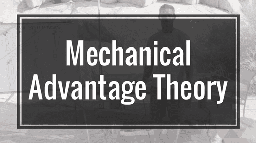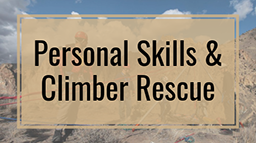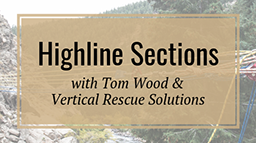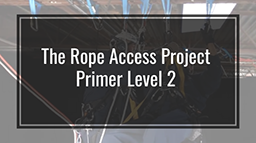Get an overview of what mechanical advantage theory is, how it works, and how it can be applied on the field.
About This Course
Mechanical Advantage is a measure of the force multiplication achieved by using a tool. In most cases, this involves using pulleys, but that isn’t always the case. The purpose is to show how we can achieve more work with less people AND that sometimes having more people can actually be dangerous. An overeager group of strapping young men and women on a given mechanical advantage system can yield an explosion of power, that when not desired, could actually create problems.
We’ll start the Mechanical Advantage Theory course by getting an overview of what mechanical advantage theory is and how progressions work to build advantage into a system sequentially. Now, the word “theory” should grab your attention; it’s a vacuum word, and we don’t work in vacuums. Life throws all kinds of stuff at us and systems are no different. So, we’re aiming at introducing you to the personality and characteristics of mechanical advantage systems. And yes, we’ll be covering much more in the advanced Technician section that follows.
Most systems in place are used during either raise or lower systems, so we’ll focus on these two areas. However, we all know that while these make up roughly 70%-80% of our mechanical advantage needs, there are other areas we want to make you aware of.
What You’ll Learn
We’ll cover, in-depth, things like horizontal systems and elevated system later, but we’ll touch briefly on these here to give you some circumspection. Other topics you’ll learn about include:
Haul system basics and pulley systems on rope
The framework for which how to determine mechanical advantage via the T-Method
Mechanical advantage progression from 3:1 to 9:1
Quick rules of thumb for fieldwork
Complex Systems where Mechanical Advantage systems are used
And more!
Course Curriculum
Unit 1: Welcome
1.1 Welcome to Mechanical Advantage Theory
Unit 2: Mechanical Advantage Overview
2.1 Mechanical Advantage Overview
2.2 Video Tutorial: Introduction to Concepts of Mechanical Advantage
2.3 Video Tutorial: Haul System Basics & Pulley Systems on Rope (Includes T-Method)
2.4 Quiz: Mechanical Advantage Overview
Unit 3: Mechanical Advantage, Part 1
3.1 Mechanical Advantage, Part 1
3.2 Functionality of Mechanical Advantage
3.3 Mechanical Advantage Progression
3.4 PULLEYS AND MECHANICAL ADVANTAGE SYSTEMS
3.5 Progressing to the Next Level in Understanding Mechanical Advantage
3.6 System Efficiency of Mechanical Advantage Systems
3.7 Video Tutorial: Mechanical Advantage, Part 1
3.8 Video Tutorial: Calculation of MA with the T-Method in a Simple System
3.9 Video Tutorial: T-Method Applied to Mechanical Advantage Systems Using Rope Grabs, Part 2
3.10 Quiz: Mechanical Advantage, Part 1
Unit 4: Mechanical Advantage, Part 2
4.1 Mechanical Advantage, Part 2
4.2 Video Tutorial: Mechanical Advantage, Part 2
4.3 Video Tutorial: Mechanical Advantage Using the T-Method with a Horizontal System
4.4 Video Tutorial: Determining Mechanical Advantage Using the T-Method with an Added Pulley on the Load
4.5 Video Tutorial: Foundations & Concepts of Slackline Rigging 1: Multipliers
4.6 Video Tutorial: Foundations & Concepts Rigging 2: Increasing Mechanical Advantage
4.7 Quiz: Understanding Resultants: A Case Study
Unit 5: Mechanical Advantage, Part 3
5.1 Mechanical Advantage, Part 3
5.2 Video Tutorial: Mechanical Advantage, Part 3
5.3 Video Tutorial: Two Rope Offset
5.4 Quiz: Mechanical Advantage, Part 3
Unit 6: Compound Progression
6.1 Compound Progression
6.2 Video Tutorial: Using the CMC MPD in a Ganged Haul System Mechanical Advantage
6.3 Video Tutorial: How to Build and Assemble the Aztek Elite Kit Simple Pulley System
6.4 Video Tutorial: Fast Fours Mechanical Advantage
6.5 Video Tutorial: Staggered Anchors to Increase MA
6.6 Quiz: Compound Progressions
Unit 7: Simple, Compound & Complex Systems in Action
7.1 Simple, Compound & Complex Systems in Action
7.2 Video Tutorial: Mechanical Advantage Pulley System for Rope Rescue Access Rigging
7.3 Video Tutorial: Basic Highlines / Single Trackline Bonus
7.4 Video Tutorial: Dynamic Directionals Bonus
7.5 Video Tutorial: Horizontal Rigging Bonus: English Reeve
7.6 Video Tutorial: Horizontal Rigging Bonus: Norwegian Reeve
7.7 Video Tutorial: Pulley System and Mechanical Advantage 5:1 to 9:1 Progression
7.9 Quiz: Simple, Compound & Complex Systems in Action
7.8 Video Tutorial: Inside 9 Pulley Complex System Using the AZTEK and the CMC MPD and Petzl Id
Unit 8: Wrap Up
8.1 Wrap Up
Added Perks
Additional features Rigging Lab Academy Members are enjoying
Certificate of Completion
Download your personalized Certificate of Completion after completing the course.
100% Self-Paced
Go through the course material as fast or as slow as you’d like.
Private Discussion Board
Ask questions, meet other students, and even chat with the course instructor.





